
Pseudocoremia suavis, the common forest looper, is a species of moth in the family Geometridae. It is regarded as being endemic to New Zealand. In 2007, however, the moth was found in west Cornwall, Great Britain, the first time it has been found outside of New Zealand.
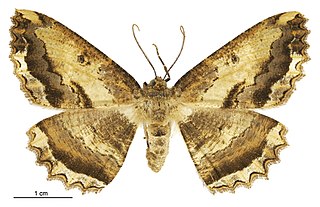
Gellonia dejectaria, the brown evening moth, is a moth in the family Geometridae. The species was first described by Francis Walker in 1860. It is endemic to New Zealand.
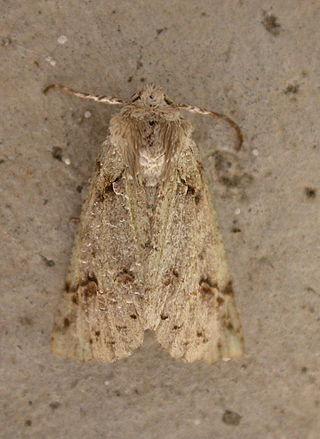
Declana is a genus of moths in the family Geometridae that is endemic to New Zealand. The genus was erected by Francis Walker in 1858.

Pseudocoremia fenerata is a moth of the family Geometridae. It is endemic to New Zealand.
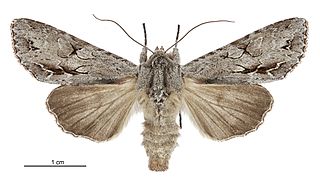
Ichneutica ustistriga is a moth of the family Noctuidae. It is endemic to New Zealand and can be found from the Three Kings Islands to Stewart Island. This species lives in a wide variety of habitats including domestic gardens, horticultural areas, orchards, native and exotic grasslands, as well as native forest. The larvae eat a variety of herbaceous plants. Recorded food plants include Muehlenbeckia australis, Muehlenbeckia complexa, Olearia hectorii, Plantago lanceolata, and Urtica australis. This moth has a mauvish grey wing colour and is unlikely to be confused with other species as the patterns on its forewing are distinctive. This species is on the wing throughout the year and is attracted to both sugar and light traps. Adult moths can be found at rest on fences and tree trunks during the day.

Izatha attactella is a moth of the family Oecophoridae. This species is endemic to New Zealand, where it is known from both the North and South Islands as far south as mid-Canterbury. Larvae of this species feed on the soft inner surface of the bark of dead trees and shrubs. Adults have been recorded from September to December.

Heterocrossa exochana is a species of moth in the family Carposinidae. It is endemic to New Zealand.

Chloroclystis inductata is a moth of the family Geometridae. It is endemic to New Zealand. It was first described by Francis Walker in 1862. The male of this species can be easily identified by the distinctive 'scalloping' of the hindwings.

Pasiphila muscosata, the emerald pug moth, is a moth in the family Geometridae. It is endemic to New Zealand and has been found in the North, South and Stewart Islands. The larvae of this species are known to be present in January and live on Muehlenbeckia species including Muehlenbeckia australis. The larvae tends to be brown but it is variable in both colour and markings. The larvae of this species pupates in a loose cocoon on the ground and adult moths emerge in September. Adults are commonly on the wing until the following May. Although adults tend to be a deep emerald green colour this species is again variable and there is also an orange-yellow variety as well as intermediate forms. Adults are attracted to light and often rest during the day on tree trunks.
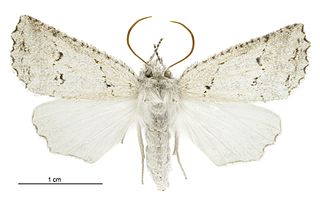
Declana niveata is a species of moth in the family Geometridae. It is endemic to New Zealand. This species was first described by Arthur Gardiner Butler in 1879. The larvae of this species feed on Hoheria species.
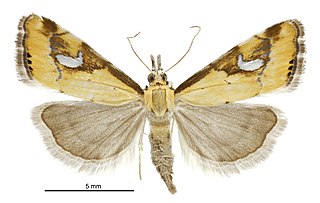
Glaucocharis lepidella is a moth in the family Crambidae. It was described by Francis Walker in 1866. It is endemic to New Zealand. Larvae of this species feed on mosses.

Bityla defigurata is a moth of the family Noctuidae. It is endemic to New Zealand.

Declana griseata is a species of moth in the family Geometridae. It is endemic to New Zealand. This species is classified as "At Risk, Declining" by the Department of Conservation.

Notoreas chioneres is a species of moth in the family Geometridae. This species is endemic to New Zealand.

Tingena is a genus of the concealer moth family (Oecophoridae). This genus is endemic to New Zealand.
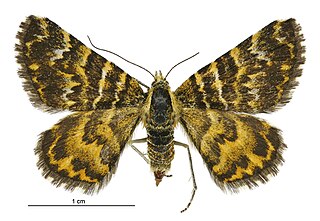
Notoreas elegans is a species of moth in the family Geometridae, endemic to New Zealand. This species has a wide distribution in New Zealand and is therefore regarded as not being in need of conservation.

Notoreas isoleuca is a species of moth in the family Geometridae. It is endemic to New Zealand.
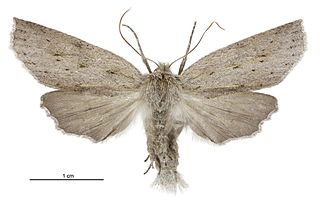
Declana leptomera is a species of moth in the family Geometridae. It is endemic to New Zealand.

Pseudocoremia lupinata is a species of moth in the family Geometridae. It is endemic to New Zealand and can be found in both the North and South Islands. The favoured habitat of this species is Kānuka scrubland as one of its larval hosts is Kunzea ericoides. Other larval host plant species of this moth include Prumnopitys ferruginea, Podocarpus totara and Pinus radiata. Both the larvae and adults of this species are nocturnal. Adult moths are commonly on the wing from December to June and are attracted to light.




















